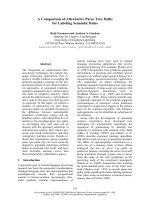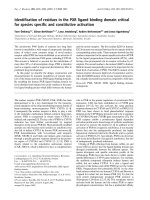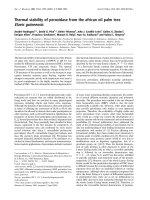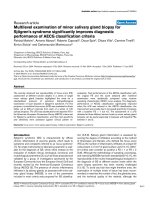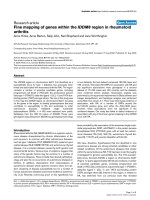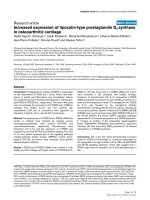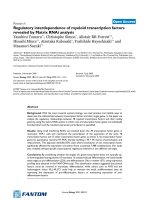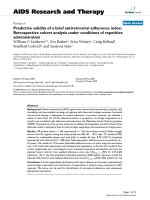Bóa cáo y học: "Priority setting of health interventions: the need for multi-criteria decision analysis" ppt
Bạn đang xem bản rút gọn của tài liệu. Xem và tải ngay bản đầy đủ của tài liệu tại đây (310.41 KB, 9 trang )
BioMed Central
Page 1 of 9
(page number not for citation purposes)
Cost Effectiveness and Resource
Allocation
Open Access
Methodology
Priority setting of health interventions: the need for multi-criteria
decision analysis
Rob Baltussen*
1,2
and Louis Niessen
1,3
Address:
1
Institute for Medical Technology Assessment (iMTA), ErasmusMC Rotterdam, Rotterdam, The Netherlands,
2
Department of Public
Health, University Medical Centre Nijmegen, Nijmegen, The Netherlands and
3
Department of Health Policy and Management, ErasmusMC,
Rotterdam, The Netherlands
Email: Rob Baltussen* - ; Louis Niessen -
* Corresponding author
Abstract
Priority setting of health interventions is often ad-hoc and resources are not used to an optimal
extent. Underlying problem is that multiple criteria play a role and decisions are complex.
Interventions may be chosen to maximize general population health, to reduce health inequalities
of disadvantaged or vulnerable groups, ad/or to respond to life-threatening situations, all with
respect to practical and budgetary constraints. This is the type of problem that policy makers are
typically bad at solving rationally, unaided. They tend to use heuristic or intuitive approaches to
simplify complexity, and in the process, important information is ignored. Next, policy makers may
select interventions for only political motives.
This indicates the need for rational and transparent approaches to priority setting. Over the past
decades, a number of approaches have been developed, including evidence-based medicine, burden
of disease analyses, cost-effectiveness analyses, and equity analyses. However, these approaches
concentrate on single criteria only, whereas in reality, policy makers need to make choices taking
into account multiple criteria simultaneously. Moreover, they do not cover all criteria that are
relevant to policy makers.
Therefore, the development of a multi-criteria approach to priority setting is necessary, and this
has indeed recently been identified as one of the most important issues in health system research.
In other scientific disciplines, multi-criteria decision analysis is well developed, has gained
widespread acceptance and is routinely used. This paper presents the main principles of multi-
criteria decision analysis. There are only a very few applications to guide resource allocation
decisions in health. We call for a shift away from present priority setting tools in health – that tend
to focus on single criteria – towards transparent and systematic approaches that take into account
all relevant criteria simultaneously.
Background
Pertaining health needs and accelerating technological
development put an ever-increasing demand on limited
health budgets. Policy makers need to make important
decisions on the use of public funds – to target which dis-
ease areas, which populations, and with which interven-
tions. However, these choices may not be based on a
rational and transparent process, and resources may not
Published: 21 August 2006
Cost Effectiveness and Resource Allocation 2006, 4:14 doi:10.1186/1478-7547-4-14
Received: 01 March 2006
Accepted: 21 August 2006
This article is available from: />© 2006 Baltussen and Niessen; licensee BioMed Central Ltd.
This is an Open Access article distributed under the terms of the Creative Commons Attribution License ( />),
which permits unrestricted use, distribution, and reproduction in any medium, provided the original work is properly cited.
Cost Effectiveness and Resource Allocation 2006, 4:14 />Page 2 of 9
(page number not for citation purposes)
be used to an optimal extent [1,2]. For example, despite
evidence that investing in primary health care is more
effective than investing in specialized health care, alloca-
tions to primary care in Ghana have remained behind
those allocated to tertiary care [3]. The underlying prob-
lem is that decisions on the choice of health interventions
are complex and multifaceted [4,5], and the process is
therefore ad-hoc or history-based [1,2]. Many criteria, or
factors, play a role, and present the type of problem that
behavioral decision research shows policy makers are typ-
ically quite bad at solving, unaided [6,7] (Figure 1).
A first, and probably most important, criterion is the soci-
etal wish to maximize general population health. This has
indeed been the basis of many national disease programs
in the past century [8]. A second set of criteria relates to
the distribution of health in the population. Societies may
give high priority to interventions that target vulnerable
population groups such as the poor [9,10], the severely ill
[11], or children or women of reproductive age [12],
because they are more deserving of health care than others
[13,14]. Also, societies may give high priority to the eco-
nomically productive people to stimulate economic
growth [15], or low priority to people who require health
care as a result from irresponsible behavior (e.g. smoking)
[16]. A third set of criteria responds to specific societal pref-
erences, e.g. for acute care in life threatening situations, or
for curative over preventive services [17].
A fourth set of criteria relates to the budgetary and practical
constraints that policy makers face when implementing
interventions, including costs and availability of trained
health workers [18], and may take these into account
when choosing between interventions. Fifthly, political
criteria may play an important role. Policy makers may
not always be benevolent maximizers of social welfare,
but may also act out of own (political) self-interest [19].
Interests groups in societies exercise their influence on
policy makers to prioritise interventions according to their
objectives, and policy makers may be sensitive to this in
their efforts to maximize political support. For example,
health expenditures in many developing countries are
often focused on services for richer areas or groups at the
expense of the poor, even where the latter offers greater
scope for cost-effective healthcare [19]. Also, policy mak-
ers may follow funding preferences of (international)
organisations, which may not always cohere with national
priorities [20-22]. The above list may not be exhaustive,
and still other criteria may be important.
When confronted with such complex problems, policy-
makers tend to use intuitive or heuristic approaches to
Ad hoc priority setting and rational priority settingFigure 1
Ad hoc priority setting and rational priority setting.
'HFLVLRQPDNHU
$YHUD
J
H
S
R
S
XODWLRQKHDOWK
6HYHULW
\
RIGLVHDVH
9XOQHUDEOH
S
R
S
XODWLRQV
'LVHDVHVRIWKH
S
RRU
(PHU
J
HQF
\
VLWXDWLRQV
(FRQRPLF
J
URZWK
(DVHRILP
S
OHPHQWDWLRQ
,UUHV
S
RQVLEOHEHKDYLRXU
%XUGHQRIGLVHDVH
%XG
J
HWLP
S
DFW
&RVWHIIHFWLYHQHVV
%XUGHQRI
GLVHDVH
DQDO\VLV
&RVW
HIIHFWLYHQHVV
DQDO\VLV
(TXLW\
DQDO\VLV
$GKRF3ULRULW\6HWWLQJ
(YLGHQFH
EDVHG
PHGLFLQH
3ROLWLFDOVHO
I
LQWHUHVW
3UHIHUHQFHVRIIXQGLQ
J
ERGLHV
'HFLVLRQPDNHU
$YHUD
J
H
S
R
S
XODWLRQKHDOWK
6HYHULW
\
RIGLVHDVH
'LVHDVHVRIWKH
S
RRU
(PHU
J
HQF
\
VLWXDWLRQV
*OREDO
S
DUDGL
J
PV
(DVHRILP
S
OHPHQWDWLRQ
,UUHV
S
RQVLEOHEHKDYLRXU
%XUGHQRIGLVHDVH
%XG
J
HWLP
S
DFW
&RVWHIIHFWLYHQHVV
%XUGHQRI
GLVHDVH
DQDO\VLV
&RVW
HIIHFWLYHQHVV
DQDO\VLV
(TXLW\
DQDO\VLV
$GKRF3ULRULW\6HWWLQJ
(YLGHQFH
EDVHG
PHGLFLQH
3ROLWLFDOVHO
I
LQWHUHVW
3UHIHUHQFHVRIIXQGLQ
J
ERGLHV
'HFLVLRQPDNHU
6HYHULW\RIGLVHDVH
$YHUDJHSRSXODWLRQKHDOWK
(DVHRILPSOHPHQWDWLRQ
(PHUJHQF\VLWXDWLRQV
%XUGHQRIGLVHDVH
(FRQRPLFJURZWK
,UUHVSRQVLEOHEHKDYLRXU
9XOQHUDEOHSRSXODWLRQV
%XGJHWLPSDFW
'LVHDVHRIWKHSRRU
&RVWHIIHFWLYHQHVV
5DWLRQDO3ULRULW\ 6HWWLQJ
5DQNRUGHULQJRI
LQWHUYHQWLRQV
0XOWLFULWHULDGHFLVLRQDQDO\VLV
%XUGHQRI
GLVHDVH
DQDO\VLV
&RVW
HIIHFWLYHQHVV
DQDO\VLV
(TXLW\
DQDO\VLV
(YLGHQFH
EDVHG
PHGLFLQH
'HFLVLRQPDNHU
6HYHULW\RIGLVHDVH
$YHUDJHSRSXODWLRQKHDOWK
(DVHRILPSOHPHQWDWLRQ
(PHUJHQF\VLWXDWLRQV
%XUGHQRIGLVHDVH
(FRQRPLFJURZWK
,UUHVSRQVLEOHEHKDYLRXU
9XOQHUDEOHSRSXODWLRQV
%XGJHWLPSDFW
'LVHDVHRIWKHSRRU
&RVWHIIHFWLYHQHVV
5DWLRQDO3ULRULW\ 6HWWLQJ
5DQNRUGHULQJRI
LQWHUYHQWLRQV
0XOWLFULWHULDGHFLVLRQDQDO\VLV
%XUGHQRI
GLVHDVH
DQDO\VLV
&RVW
HIIHFWLYHQHVV
DQDO\VLV
(TXLW\
DQDO\VLV
(YLGHQFH
EDVHG
PHGLFLQH
Cost Effectiveness and Resource Allocation 2006, 4:14 />Page 3 of 9
(page number not for citation purposes)
simplify complexity, and in the process, important infor-
mation may be lost, and priority setting is ad-hoc. Or
worse, they act out of political self-interest and prioritize
interventions according to their own objectives. In other
words, policy makers may not always well placed to make
informed well-thought choices involving trade-offs of
societal values [6,7].
The above indicates the need for a rational and transpar-
ent approach to priority setting that guides policy makers
in their choice of health interventions, and that maxi-
mizes social welfare. This paper presents an overview of
the approaches that have been developed over the past
decades, and argues that these offer little guidance to pol-
icy makers. They concentrate on single criteria only,
whereas in reality, policy makers need to make choices
taking into account multiple criteria simultaneously.
Moreover, they do not cover all criteria that are relevant to
policy makers. In other disciplines, multi-criteria decision
analysis (MCDA) is routinely used in similar problems,
and we show its basic concepts and most important meth-
ods. We call for the application of MCDA in health, and
present some first examples.
Rational approaches to priority setting
The past decades have witnessed the development of
number of rational and transparent approaches to priority
setting. Most prominent has been the development of evi-
dence-based medicine, or the use of interventions with
established effectiveness. This dates back to the beginning
of the last century but was institutionalized by the foun-
dation of the Cochrane Collaboration in 1993 [23-25].
The Cochrane Collaboration produces and disseminates
systematic reviews of healthcare interventions and pro-
motes the search for evidence in the form of clinical trials
and other studies of interventions.
Because of steep increases in health interventions costs in
western countries in the 1980's, economists proposed the
use of cost-effectiveness analysis of health interventions. The
underlying notion is that interventions should not only
have established effectiveness, but should also be worth
its costs [26]. For a certain budget, population health
would then maximized by choosing interventions that
show best value for money ('most cost-effective'). The
World Bank promoted the concept in developing coun-
tries in 1993 [27] and recently the World Health Organi-
zation have made such information available at the
regional level through the WHO-CHOICE project, e.g. on
tuberculosis and HIV/AIDS control [28-30]. Work is
underway to apply these cost-effectiveness estimates to
the country level [31].
Also in the early 1990's, the World Bank expanded epide-
miological mortality measures to the concept of burden of
disease analysis [32]. Burden of disease analysis measures
ill health in terms of morbidity and mortality to indicate
the most important disease areas in a country. Its propo-
nents consider the analysis as an important aid to priority
setting as it would guide policy makers in targeting their
intervention at the most important disease areas. Others
argue that it lacks a conceptual basis for priority setting of
health interventions, as the size of a disease problem has
no relation to the potential for effective reduction [33].
Nevertheless, burden of disease analysis has been applied
in many developed and developing countries including
Eritrea, Kenya, Ethiopia, Uganda, and Tanzania in East
Africa, Algeria, Morocco and Tunis in Northern Africa, and
India [34,35].
With advances in population health in developing coun-
tries in the past decades, policy makers have increasingly
become aware of disparities in health status between dif-
ferent groups in society. The past few years has witnessed
an increased attention for equity analyses describing the
distributional impact of interventions [9-12]. These stud-
ies aim to analyze to the extent interventions reach and
benefit disadvantages groups, such as the poor or certain
ethnicities, or otherwise vulnerable populations.
The need for multi-criteria decision analysis
However, the above approaches offer limited guidance to
policy makers in their choice of interventions, for a
number of reasons. Firstly, they were developed in isola-
tion from each other, and concentrate on single criteria for
priority setting – be it effectiveness, cost-effectiveness, bur-
den of disease, or equity analysis, and do not advice on
how to integrate or judge the relative importance of each
criterion. In reality, policy makers need to make choices
on interventions taking those criteria into account simul-
taneously. Moreover, criteria can easily conflict. For exam-
ple, interventions targeting marginalized populations in
remote areas of a country are likely to be more costly and
therefore less cost-effective than those covering only peo-
ple in urban areas [36]. Also, not all criteria are equally
important: depending on the pro-poor stance of a coun-
try, policy makers may value interventions that target the
poor more highly than those that stimulate economic
growth.
Secondly, these approaches do not cover all criteria that
are relevant to policy makers. For example, they are not
able to capture preferences of society regarding 'the rule of
rescue' in acute cure or regarding interventions related to
irresponsible behavior of patients. A further complicating
factor is that prioritisation decisions typically draw upon
multidisciplinary knowledge bases, incorporating clinical
medicine, public health, social sciences and ethics, and
policy makers lack expertise to adequately interpret on all
these aspects.
Cost Effectiveness and Resource Allocation 2006, 4:14 />Page 4 of 9
(page number not for citation purposes)
As a result, policy makers may not be able to utilize all
available and necessary information in choosing between
different interventions, and priority setting is ad-hoc (Fig-
ure 1). This stresses the need for the scientific develop-
ment of MCDA to support priority setting, which has
recently indeed been identified as one of the most impor-
tant issues in health system research [5]. Baltussen and
others have argued that MCDA should allow a trade-off
between various criteria, and should establish the relative
importance of criteria in a way that allows a rank ordering
of a comprehensive set of interventions [4,37] (Figure 1).
The underlying idea is that policy makers fund interven-
tions according to this rank ordering until their budget is
exhausted.
Methods of multi-criteria decision analysis
In stark contrast with the near-absence of applications of
MCDA to allocation decisions in health care is the wide-
spread acceptance and routine use of MCDA in other dis-
ciplines, e.g. to structure remedial decisions at
contaminated sites in environmental sciences [38].
MCDA has also been applied in agricultural [39], energy
[40], and marketing [41] sciences. In those disciplines,
MCDA has evolved as a response to the observed inability
of people to effectively analyze multiple streams of dis-
similar information. The analysis establishes preferences
between options by reference to an explicit set of objec-
tives that the decision making body has identified, and for
which it has established measurable criteria to assess the
extent to which the objectives have been achieved [42].
MCDA offers a number of ways of aggregating the data on
individual criteria to provide indicators of the overall per-
formance of options.
This section outlines the main principles of MCDA, heav-
ily drawing on standard works in those disciplines [42-
45]. Wherever we use to term 'option' in this paper, this
refers to 'intervention' in the context of priority setting in
health, and the terms are used interchangeably. It first
presents the performance matrix, which is a standard fea-
ture of every multi-criteria analysis. Next, it explains how
the basic information in the performance matrix can be
processed – either qualitatively or quantitatively.
The performance matrix
In a performance matrix, each row describes an option
and each column describes the performance of the
options against each criterion. The criteria are the meas-
ures of performance by which the options will be judged,
and must be carefully selected, to assure completeness,
feasibility, and mutual independence, and avoid redun-
dancy and an excessive number of criteria. The individual
performance assessments are often qualitative descrip-
tions, or natural units, or sometimes a (crude) numerical
scale [42]. Table 1 shows a simplified example, on the
basis of the performance of a number of different inter-
ventions in regard to a set of criteria thought to be relevant
in policy making. These criteria are cost-effectiveness,
severity of disease, whether a disease is more among the
poor, and age. As can be seen, some of these criteria are
measured on a binary scale (a tick indicates a disease is
more prevalent among the poor than among the rich),
nominal scale (age), ordinal scales (severity of disease), or
ratio scale (cost-effectiveness).
Qualitative analysis of the performance matrix
The performance matrix may be the final product of the
analysis, allowing the decision maker to qualitatively rank
the options. Such intuitive processing of the data can be
quick and effective, but it may also lead to the use of
unjustified assumptions, causing incorrect ranking of
options [42]. The decision maker can come to a few types
of comparisons.
Dominance
Direct inspection of the performance matrix can show if
any of the options are dominated by others. Dominance
occurs when one option performs at least as well as
another on all criteria and strictly better than the other on
at least one criterion. In practice, dominance is likely to be
rare, and the extent to which it can help to discriminate
between many options and to support real decisions is
correspondingly limited.
Subjective interpretation
Decision makers may also use the performance matrix to
add recorded performance levels across the rows
(options) to make some holistic judgment between
options about which ones are better. However, this
Table 1: Performance matrix
Options Cost-effectiveness Severity of disease Disease of the poor Age
Antiretroviral treatment in HIV/AIDS US$200 per DALY ●●●● √ 15 years and older
Treatment of childhood pneumonia US$20 per DALY ●●●● √ 0–14 years
Inpatient care for acute schizophrenia US$2000 per DALY ●● 15 years and older
Plastering for simple fractures US$50 per DALY ● all
A tick indicates the presence of a feature. Severity of disease is shown of a four-star scale, with more stars indicating a more severe disease.
Cost Effectiveness and Resource Allocation 2006, 4:14 />Page 5 of 9
(page number not for citation purposes)
implies that all criteria contribute with equal importance
to options' overall performance, when this has not been
established. More generally, a subjective interpretation of
the matrix is prone to many well-documented distortions
of human judgments [6,7]. In marketing, this method is
also called the 'pros and cons' or 'balance sheet' analysis,
and is used by salespeople to gain commitment from a
buyer by asking to think of the pros and cons of various
alternatives [41].
Quantitative analysis of the performance matrix
In analytically more sophisticated MCDA techniques the
information in the basic matrix is usually converted into
consistent numerical values. The key idea is to construct
scales representing preferences for the consequences, to
weight the scales for their relative importance, and then to
calculate weighted averages across the preference scales
[42].
First, the expected consequences of each option are
assigned a numerical score reflecting the strength of pref-
erence scale for each option for each criterion. More pre-
ferred options score higher on the scale, and less preferred
options score lower. The scoring can be based on a value
function, which translates a measure of achievement on
the criterion in to a value score on the scale. Alternatively,
when a commonly agreed scale of measurement does not
exist, direct rating can be used and is based on the judg-
ment of an expert simply to associate a number on that
scale with the value of each option on that criterion. Or,
scores can be obtained by eliciting from the decision
maker a series of verbal pair wise assessments expressing a
judgment of the performance of each option relative to
each of the others (e.g. the Analytical Hierarchy Process
does this (see below)). The scores are presented in Table 2
in normal figure.
Second, numerical weights are assigned to define, for each
criterion, the relative valuations of a shift between the top
and bottom of the chosen scale. Weights can be obtained
by comparing weights of criterions to the most important
criterion, e.g. on the basis of group discussions. In a next
step, those weights are calculated to sum up to 100 in
total. In the example in Table 2, weights are presented in
bold figure: 'cost-effectiveness' and 'disease of the poor'
are both assigned a value of 40, and the other criteria a
value of 10.
Mathematical routines then combine these two compo-
nents to give an overall assessment of each option being
appraised. At this stage, it is important to determine
whether trade-offs between different criteria are accepta-
ble, so that good performance on one criterion can in
principle compensate for weaker performance on another.
Most public decisions admit such trade-offs, but there
may be some circumstances, perhaps where ethical issues
are central, where trade-offs of this type are not accepta-
ble. If it is not acceptable to consider trade-offs between
criteria, then there are a limited number of non-compen-
satory MCA techniques available [42]. Where compensa-
tion is acceptable, and low scores on one criterion may be
compensated by high scores on another, compensatory
MCA techniques are used that involve aggregation of each
option's performance across all the criteria to form an
overall assessment of each option, on the basis of which
the set of options can be compared. These techniques are
usually based on multi-attribute utility theory [46]. The
principal difference between the main families of MCA
methods is the way in which this aggregation is done.
The simple linear additive evaluation model
If it can either be proved, or reasonably assumed, that the
criteria are preferentially independent of each other, then
the simple linear additive evaluation model is applicable.
The linear model shows how an option's values on the
many criteria can be combined into one overall value.
This is done through multiplication of the value score on
each criterion by the weight of that criterion, and then
adding all those weighted scores together. For example, in
Table 2, antiretroviral treatment in HIV/AIDS scores 50 on
Table 2: Scoring the options.
Options Cost-effectiveness Severity of disease Disease of the poor Age Total
Antiretroviral treatment in HIV/AIDS 50 100 100 0 70
Treatment of childhood pneumonia 100 100 100 100 100
Inpatient care for acute schizophrenia 0 50 0 0 5
Plastering for simple fractures 100 25 0 50 48
Weights 40 10 40 10
Preference scores for 'cost-effectiveness' are obviously inverse to its values, and are based on three categories: it scores 0 if the cost-effectiveness
is higher than US$300 per DALY, 50 if between US$100 and US$300, and 100 if below US$100 per DALY. For 'disease of the poor', if the feature
is present, it scores 100, otherwise 0. Preference scores for 'severity of disease' are scaled between 0 and 100 in proportion to their stars.
Assuming decision makers have a preference to treat young people over old, '0–14 years' receives a score of 100, '15 years and older' a score of 0,
and 'all ages' a score of 50. Preference scores are presented here for illustrative purposes only, and are arbitrary.
Cost Effectiveness and Resource Allocation 2006, 4:14 />Page 6 of 9
(page number not for citation purposes)
the criterion 'cost-effectiveness', and the weight of that cri-
terion is 40/100: the weighted score is then 50 * 40/100 =
20. In a similar way, the weighted scores on 'severity of
disease', 'disease of the poor', and 'age' are respectively 10,
40, and 0. The weighted scores sum up to 70, which is
shown in the final column. Treatment of childhood pneu-
monia has a total score of 100, and is therefore the pre-
ferred option, followed by antiretroviral treatment in
HIV/AIDS, plastering for simple fractures (48), and inpa-
tient care for acute schizophrenia (5).
The analytical hierarchy process
The analytic hierarchy process also develops a linear addi-
tive model, but, in its standard format, uses procedures for
deriving the weights and the scores achieved by alterna-
tives, which are based, respectively, on pair wise compari-
sons between criteria and between options. Thus, for
example, in assessing weights, the decision maker is asked
a series of questions, each of which asks how important
one particular criterion is relative to another for the deci-
sion being addressed.
Outranking methods
A rather different approach depends upon the concept of
outranking, and seeks to eliminate alternatives that are, in
a particular sense, 'dominated'. However, unlike the
straightforward dominance idea outlined above, 'out-
ranked dominance' gives more influence to some criteria
than others. One option is said to outrank another if it
outperforms the other on enough criteria of sufficient
importance (as reflected by the sum of the criteria
weights) and is not outperformed by the other option in
the sense of recording a significantly inferior performance
on any one criterion. The outranking concept indirectly
captures some of the political realities of decision-making,
by downgrading options that perform badly on any one
criterion (which might in turn activate strong lobbying
from concerned parties and difficulty in implementing
the option in question). In the example, in Table 1, all
interventions are outranked by 'treatment of child pneu-
monia', and this illustrates its low discriminative power
and hence its limited potential for priority setting, espe-
cially in the context of many criteria and many interven-
tions.
Applications to health care
To date, MCDA knows very few applications to guide
resource allocation decisions in health care, in either west-
ern or developing countries. These applications have used
MCDA to different extents: to only illustrate its principles,
to identify the criteria for priority setting, to identify and
weigh the criteria for priority setting, or more comprehen-
sive approaches that result in a rank ordering of interven-
tions.
James et al. [47] illustrated the principles of MCDA by dem-
onstrating the potential impact of alternative weights for
equity and efficiency criteria on the ranking of a number
of hypothetical interventions.
The criteria for priority setting were identified by two
merely qualitative studies in Uganda [4,48], including
medical (e.g. effectiveness, cost-effectiveness, quality of
evidence, severity of disease) and non-medical criteria
(e.g. age, gender, and area of residence). Yet, they did not
establish the weights of these criteria in a way that allows
a rank ordering of interventions. Recently, a number of
tools have been developed that take into account various
criteria, but these do not explicitly attach weights to these
criteria. Tugwell et al. [49] have proposed the 'equity effec-
tiveness loop' to highlight equity issues inherent in assess-
ing health needs, effectiveness and cost-effectiveness of
interventions. The 'marginal budgeting for bottlenecks'
tool aims to bridge between costing, cost-effectiveness
and burden of disease analysis [50]. 'District health
accounts' is a tool designed to help districts analyze their
budgets and expenditures so that budgets can be set
against priorities as defined by the prevailing burden of
disease, and as such integrates budgeting, costing and bur-
den of disease analysis [51]. In the Netherlands, Dunning
identified a number of criteria for public reimbursement
of health care. However, some of its criteria – especially
medical need – were not well defined, and its application
therefore suboptimal [52].
Further studies have quantified the scores and weights of cri-
teria, but these are typically limited to two criteria only:
e.g. on cost-effectiveness and equity [53], or on age and
severity of illness [54,55].
Recently, two comprehensive MCDA approaches have
been developed. Wilson et al. [56] developed a prioritiza-
tion framework in an English Primary Care Trust. Through
group discussion with policy makers, a number of criteria
were identified (such as effectiveness, quality of life,
access/equity, need, and prevention) and were weighed
into four broad 'levels of importance'. Next, the groups
scored four hypothetical interventions on those criteria on
a scale from 0–10. A simple linear additive evaluation
model was used to calculate overall scores, and interven-
tions were rank ordered according to their 'cost-value'
ratio (estimated by dividing the costs of an interventions
by the overall score). The authors consider the framework
as a promising tool for prioritizing interventions in the
Primary Care Trust.
Baltussen et al. carried out explorative research to priori-
tize health interventions in Ghana and Nepal using dis-
crete choice experiments [37,57]. In Ghana, criteria were
identified through a series of group discussions with pol-
Cost Effectiveness and Resource Allocation 2006, 4:14 />Page 7 of 9
(page number not for citation purposes)
icy makers, and included 'cost-effectiveness', 'poverty
reduction', 'age', 'severity of illness', 'budget impact' and
'burden of disease'. Intervention scores on those criteria
were based on poverty profiles, burden of disease and
cost-effectiveness analysis as presented in the World
Health Report 2002 [58], and were expressed on a binary
scale with arbitrary cut-off values. The relative weights of
the various criteria were estimated through the use of dis-
crete choice experiments (DCE) [59], with a large number
of policy makers. In the DCE, respondents choose their
preferred option from sets of hypothetical interventions,
each consisting of a bundle of criteria that described the
intervention in question, with each criterion varying over
a range of scores (Figure 2). The criteria were constant in
each scenario, but the scores that described each criterion
varied across interventions. Analysis of the options cho-
sen by respondents in each set revealed the extent to
which each criterion was important. The work in Ghana
showed that policy makers give high value to interven-
tions that are cost-effective (score of 1.42), reduce poverty
(1.25), target the young (0.84), or target severe diseases
(0.38). Using a simple linear additive evaluation model,
total scores were calculated for a set of interventions, and
rank ordered accordingly: high priority interventions in
Ghana were prevention of mother to child transmission
in HIV/AIDS control, and treatment of pneumonia and
diarrhea in childhood. Lower priority interventions were
certain interventions to control blood pressure, tobacco
and alcohol abuse. Full details are reported elsewhere
[37].
Conclusion
This paper has shown the basic principles of MCDA, and
the need for its application in health. Whereas decisions
in health care are often characterized by informal judg-
ment unsupported by analysis, MCDA may be an impor-
tant tool towards a more rational priority setting process.
This paper has introduced various approaches to MCDA,
and these are mainly characterized by how the perform-
ance matrix is interpreted. Some approaches seem more
useful to prioritise health interventions than others. First,
the priority setting process involves many criteria and
many interventions, and since intuitive processing of this
complex data can lead to unjustified conclusions, quanti-
tative rather than qualitative analyses seem apt. Second,
compensatory rather than non-compensatory techniques
seem apt as public decisions typically allow trade-offs
between criteria (perhaps except in situations where ethi-
cal issues are central). Third, because of the need to rank
order a large number of interventions rather than to iden-
tify a single (or small number of) dominant interventions,
the linear additive model seems more suitable than the
outranking method. As noted above, first experiments
with the linear additive model have been carried out in
Ghana and Nepal [37,55], and encouraging results indi-
cate the potential of the approach to inform policy makers
on actual priority setting of interventions.
This paper has illustrated the use of MCDA with some
simplified examples. In a practical application, interven-
tions may be need evaluated at different geographic cov-
erage levels, to inform decisions on the choice between
scaling up existing interventions, or implementing new
interventions. WHO-CHOICE does evaluate interven-
tions at coverage levels of 50%, 80%, and 95% for this
purpose [60,61]. In addition, interventions may need to
be evaluated not only in isolation, but also in combina-
tion, since interactions may exist between interventions in
either costs and/or effects. For this reason, WHO-CHOICE
Example of a question in a discrete choice experimentFigure 2
Example of a question in a discrete choice experiment.
Criteria Hypothetical interventions
AB
Severity of disease severe not severe
Number of potential beneficiaries small large
Age of target group young elderly
Individual health benefits small large
Poverty reduction neutral positive
Cost-effectiveness not cost-effective cost-effective
Which one would you choose?
Please tick a box
Cost Effectiveness and Resource Allocation 2006, 4:14 />Page 8 of 9
(page number not for citation purposes)
does evaluate interventions in isolation and in combina-
tion [62].
The priority setting process should be strongly embedded
in the organizational context, probably with a central role
for an advisory panel [63]. An advisory panel comprises
key stakeholders such as health personnel, policy makers,
finance and information staff, and community represent-
atives. The panel has an important role in the definition
of the relevant criteria and their relative importance for
priority setting, and making recommendations for reallo-
cating resources on the basis of MCDA results. In the lat-
ter, the advisory panel may diverge from MCDA results
because of e.g. pragmatic considerations. In other words,
while MCDA suggests a rank ordering of interventions,
this not necessarily means that interventions should be
funded accordingly till the budget is exhausted. This is
based on the notion that MCDA should not be seen as a
formulaic or technocratic approach to priority setting, but
rather as an aid to policy making.
MCDA will contribute to the fairness of the priority setting
process. According to Daniels and Sabin's ethical frame-
work of accountability for reasonableness, priority setting
is said to be fair if the priority setting process, decisions
and rationales are accessible and relevant; and an appeals
and enforcement mechanism are established [64]. MCDA
contributes to the first two conditions because of its sys-
tematic and transparent nature.
We call for a shift away from present tools for priority set-
ting – that tend to focus on single criteria for priority set-
ting – towards transparent and systematic approaches that
take into account all relevant criteria simultaneously.
Although very little work has been done so far on compre-
hensive MCDA approaches, a number of tools that aim to
bridge the different analytical approaches are being devel-
oped. It is time to assess the current state of the art of the
methods, and to stimulate the development of a new gen-
eration of more evidence-based priority setting tools.
References
1. Ham C: Priority setting in health care: learning from interna-
tional experience. Health Policy 1997, 42:49-66.
2. Robinson R: Limits to rationality: economics, economists and
priority setting. Health Policy 1999, 49:13-26.
3. MOH Republic of Ghana Ministry of Health: Health Sector Five-
Year Programme of Work: 1997–2001. Accra, Ghana: Ministry
of Health; 1998.
4. Kapiriri L, Norheim OF: Criteria for priority setting in health
interventions in Uganda. exploration of stakeholders' values.
Bull World Health Organ 2004, 82:172-9.
5. Mills A, Bennett S, Bloom G, González-Block MA, Pathmanathan I:
Strengthening health systems: the role and promise of policy
and systems research. Alliance for Health Policy and Systems
Research/Alliance for Health Policy and Systems Research (AHPSR) 2004.
6. McDaniels TL, Gregory RS, Fields D: Democratizing risk manage-
ment: successful public involvement. Risk analysis 1999,
3:497-51.
7. Bazerman MH: Judgment in Managerial Decision Making.
Fourth edition. John Wiley, New York; 1998.
8. Cooter R, Neve M, Nutton V: History of Medicine 1988–1992.
The Wellcome Series in the History of Medicine IISSN Routledge, London .
9. Wagstaff A, Van Doorslaer E: Equity in Health Care: concepts
and definitions. In Equity in the finance and delivery of health care: an
international perspective Edited by: Van Doorslaer E, Wagstaff A, Rut-
ten F. Oxford University Press, Oxford; 1993.
10. Webster J, Lines J, Bruce J, Armstrong Schellenberg JR, Hanson K:
Which delivery systems reach the poor? A review of equity
of coverage of ever-treated nets, never-treated nets, and
immunisation to reduce child mortality in Africa. Lancet Infect
Dis 2005, 5(11):709-17.
11. Bennett S, Chanfreau C: Approaches to rationing antiretroviral
treatment: ethical and equity implications. Bull World Health
Organ 2005, 83:541-7.
12. Olsen OE: Bridging the equity gap in maternal and child
health: health systems research is needed to improve imple-
mentation. BMJ
331(7520):844. 2005 Oct 8
13. Daniel Wikler , (ed): Fairness and Goodness in Health. World
Health Organization: Geneva; 2004.
14. McIntyre D, Gilson L: Redressing Disadvantage: Promoting
Vertical Equity within South Africa. Health Care Analysis 2000,
8:235-258.
15. Commission on Macroeconomics and Health: Macroeconomics
and health: investing in health for economic development.
2001 [ />]. Boston:
Center for International Development at Harvard University
(accessed 17 Oct 2005).
16. McKie L, Laurier E, Taylor RJ, Lennox AS: Eliciting the smoker's
agenda: implications for policy and practice. Soc Sci Med 2003,
56:83-94.
17. Wiseman V, Mooney G, Berry G, Tang KC: Involving the general
public in priority setting: experiences from Australia. Soc Sci
Med 2003, 56(5):1001-12.
18. Gericke CA, Kurowski C, Ranson MK, Mills A: Intervention com-
plexity – a conceptual framework to inform priority-setting
in health. Bull World Health Organ 2005, 83(4):285-93.
19. Goddard M, Hauck K, Preker A, Smith PC: Priority setting in
health – a polictical economy perspective. Health Economics Pol-
icy and Law 2006, 1:79-90.
20. Lee K, Walt G: Linking national and global population agendas:
case studies from eight developing countries. Third World Q
1995, 16:257-72.
21. Ebrahim S, Smeeth L: Non-communicable diseases in low and
middle-income countries: a priority or a distraction? Int J Epi-
demiol 2005, 34:961-966.
22. Ollila E: Global health priorities – priorities of the wealthy?
Global Health 2005, 1(1):6.
23. Summerskill W: Cochrane Collaboration and the evolution of
evidence. Lancet 366(9499):1760. 2005 Nov 19
24. Claridge JA, Fabian TC: History and development of evidence-
based medicine. World J Surg 2005, 29(5):547-53.
25. Niessen LW, Gijssels EW, Rutten FF: The evidence-based
approach in health policy and health interventions delivery.
Soc Sci Med 2000, 51(6):859-69.
26. Drummond M, McGuire A: Methods for the economic evalua-
tion of health care programmes. 2nd edition. Oxford. Oxford
University Press; 1997.
27. The World Bank World Development Report 1993: invest-
ing in Health. New York Oxford University Press; 1993.
28. Hogan DR, Baltussen R, Hayashi C, Lauer JA, Salomon JA: Achieving
the millennium development goals for health: Cost effective-
ness analysis of strategies to combat HIV/AIDS in developing
countries. BMJ 2005, 331:1431-7.
29. Baltussen R, Floyd K, Dye C: Achieving the millennium goals for
health: Cost effectiveness analysis of strategies for tubercu-
losis control in developing countries. BMJ 2005, 333:1364-1370.
30. A description of the WHO-CHOICE project 2005 [http://
www.who.int/choice].
31. Hutubessy R, Chisholm D, Edejer TT: Generalized cost-effective-
ness analysis for national-level priority-setting in the health
sector. Cost Eff Resour Alloc 1:8. 2003 Dec 19
32. Murray CJL, Lopez AD, (eds): The global burden of disease. Har-
vard School of Public Health, on behalf of the WHO and the
World Bank. Cambridge: Harvard University Press; 1996.
Publish with Bio Med Central and every
scientist can read your work free of charge
"BioMed Central will be the most significant development for
disseminating the results of biomedical research in our lifetime."
Sir Paul Nurse, Cancer Research UK
Your research papers will be:
available free of charge to the entire biomedical community
peer reviewed and published immediately upon acceptance
cited in PubMed and archived on PubMed Central
yours — you keep the copyright
Submit your manuscript here:
/>BioMedcentral
Cost Effectiveness and Resource Allocation 2006, 4:14 />Page 9 of 9
(page number not for citation purposes)
33. Mooney G, Wiseman V: Burden of disease and priority setting.
Health Econ 2000, 9(5):369-72.
34. Bobadilla JL, Cowley P, Musgrove P, Saxenian H: Design, content
and financing of an essential national package of health serv-
ices. Bull World Health Organ 1994, 72:653-662.
35. Kapiriri L, Norheim OF, Heggenhougen K: Using burden of dis-
ease information for health planning in developing countries:
the experience from Uganda. Soc Sci Med 2003, 56:2433-2441.
36. Evans DB, Lim S, Adam T, Tan-Torres Edejer T, for the WHO
CHOICE MDG Team: Evaluation of current strategies and
future priorities for improving health in developing coun-
tries. British Medical Journal . doi 10.1136/bmj.38658.675243.94 (Nov
10 2005)
37. Baltussen R, Stolk E, Chisholm D, Aikins M: Towards a composite
league table for priority setting: An application to Ghana.
Health Economics 2006. DOI: 10.1002/hec.1092
38. Linkov I, Varghese A, Jamil S, Seager TP, Kiker G, Bridges T: Multi-
criteria decision analysis: a framework for structuring reme-
dial decisions at contaminated sites. Comparative Risk Assess-
ment and Environmental Decision Making. Kluwer 2004:15-54.
39. LPNMS (Land and Plant Nutrition Management Service): MCDA –
Multi-Criteria Decision Analysis techniques, using the Aspi-
ration-Led Decision Support (ALDS) approach. 2004 [http://
www.fao.org/ag/agl/agll/infotech.htm]. (accessed 22 December 2005)
40. Hirschberg S, Dones R, Heck T, Burgherr P, Schenler W, Bauer C:
Sustainability of Electricity Supply Technologies under Ger-
man Conditions: A Comparative Evaluation. In PSI-Report
No.04-15 Paul Scherrer Institut, Villigen, Switzerland; 2004.
41. McDaniel C, Gates R, Gates RH, McDaniel CD: Marketing Research
Essentials by, John Wiley & Sons Inc; 2005.
42. National Economic Research Associated. Multi-criteria
Analysis Manual 2005 [ />index.asp?id=114]. accessed 28 January 2006
43. Keeney RL, Raiffa H: Decisions with Multiple Objectives: Per-
formances and Value Trade-Offs. Wiley, New York; 1976.
44. Olson D: Decision Aids for Selection Problems Springer Verlag, New
York; 1995.
45. Yoon KP, Hwang C-L: Multi-Attribute Decision Making, Sage, Beverley
Hills 1995.
46. Von Neumann J, Morgenstern O: Theory of Games and Economic Behav-
iour second edition. Princeton University Press, Princeton; 1947.
47. James C, Carrin G, Savedoff W, Hanvoravongchai P: Clarifying effi-
ciency-equity tradeoffs through explicit criteria, with a focus
on developing countries. Health Care Anal 2005, 13(1):33-51.
48. Kapiriri L, Arnesen T, Norheim OF: Is cost-effectiveness analysis
preferred to severity of disease as the main guiding principle
in priority setting in resource poor settings? The case of
Uganda. Cost Eff Resour Alloc 2004, 2:1.
49. Tugwell P, de Savigny D, Hawker G, Robinson V: Applying clinical
epidemiological methods to health equity: the equity effec-
tiveness loop. BMJ 2006, 332(7537):358-61.
50. Soucat A, Van Lerberghe W, Diop F: Marginal Budgeting for bot-
tlenecks: A new costing and resource allocation practice to
buy health results. The World Bank 2002.
51. de Savigny D, Munna G, Mbuya C, Mgalula L, Machibya H, Mkikima S,
Mwageni E, Kasale H, Reid G: District Health Expenditure Map-
ping: A Budget Analysis Tool for Council Health Manage-
ment Teams. In Tanzania Essential Health Interventions Project.
Discussion Paper No. 1 Dar es Salaam, Tanzania; 2001.
52. Stolk EA, Poley MJ: Criteria for determining a basic health serv-
ices package. Recent developments in The Netherlands. Eur
J Health Econ 2005, 6(1):2-7.
53. Wagstaff A: Inequality aversion, health inequalities and health
achievement. J Health Econ 2002, 21:627-41.
54. Stolk EA, Pickee SJ, Ament AH, Busschbach JJ: Equity in health care
prioritisation: an empirical inquiry into social value. Health
Policy 2005, 74(3):343-55.
55. Dolan P, Tsuchiya A: Health priorities and public preferences:
the relative importance of past health experience and future
health prospects. J Health Econ
2005, 24:703-14.
56. Wilson ECF, Rees J, Fordham RJ: Developing a prioritisation
framework in an English Primary Care Trust. Cost Effectiveness
and Resource Allocation 2006, 4:3.
57. Baltussen R, ten Asbroek G, Shrestra N, Niessen L: A rational
approach to priority setting: should a lung health program
be implemented in Nepal? iMTA Discussion paper 2005.6 2005.
58. World Health Report: Reducing Risks, Promoting Healthy Life.
World Health Organization, Geneva; 2002.
59. Ryan M, Gerard K: Using discrete choice experiments to value
health care programmes: current practice and future
research reflections. Applied Health Economics and Health Policy
2003, 2:1.
60. Johns B, Baltussen R, Adam T, Hutubessy RCW: Programmeme
costs in the economic evaluation of health interventions.
Cost Eff Resour Alloc 2003, 1:1.
61. Johns B, Baltussen R: Accounting for the costs of scaling up
health interventions. Health Economics 2004, 13:1117-1124.
62. Evans DB, Lim SS, Adam T, Tan-Torres Edejer T, the WHO-CHOICE
MDG Team: Achieving the Millennium Development Goals
for health. Methods for assessing the costs and health impact
of interventions. BMJ 2005.
63. Daniels N, Sabin J: The ethics of accountability in managed care
reform. Health Aff (Milwood) 1998, 17:50-64.
64. Peacock S, Ruta D, Mitton C, Donaldson C, Bate A, Murtagh M:
Using economics to set pragmatic and ethical priorities. BMJ
2006, 332:482-485.

